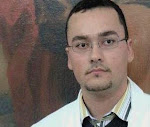An excerpt from a past online post:
The application of paint on a flat surface is a tool that replicates the
physical and the spiritual. In other words, painting can imitate what we see,
feel or think about. The art of painting is the ability to observe, memorise
and manipulate what we see in terms of shapes and colours. There are those who
are extremely good at imitating what they see - just like a photographic
camera. Such imitators just want to test and improve their painting skills,
maybe even to satisfy their need of impressing the general public with their
photographic techniques. After all, everyone can appreciate with great ease a
photographic painting of a portrait, landscape or seascape. But why should we
still be bothered to replicate a view on a paper or canvas when the exact process
can be done with the use of a digital photographic camera, possibly combined
with the use of an electronic photographic editing software, to achieve the
desired result? In fact, history of art demonstrates that the art of painting
took a very different direction immediately following the invention of the
photographic camera. Painting became more sophisticated and more challenging,
whereby the painter competed with the camera and tried to paint what the
photographic camera cannot portray. Yes, the painter tried to depict the
non-visible, the abstract, the spiritual. And this was only successful if the
painter worked while being truly haunted by a concept or overwhelmed by an
emotion. It is truly the biggest challenge to produce a painting that can transmit
particular thoughts or emotions (perceived by viewers of the painting).
However, the continuous effort to depict inner thoughts and feelings
led the artist to be more individualistic and not so much compelled to follow
one, commonly-defined style or formula. Not convinced about the latter? Just
visit the contemporary museums and galleries, or simply browse the internet for
images of contemporary paintings. You will see that there is no common style,
no common goal, no common definition of contemporary art.
Some perceive this negatively, as if we are living in an art crisis,
where artists are living in a very doubtful atmosphere. Lots of such
uncertainty has stemmed by the views of the general public which has been
scorning modern and contemporary art for ages, arguing that art became elitist
by being attractive mainly to the selective, art-knowledgeable audience.
Contemporary art gave rise to the unfortunate necessity for information panels
displayed along paintings in art galleries in order to explain the artwork. Psychologists wrote
more books and papers on the meaning of art. The artists themselves became also
more prompted to explain their work, often in front of video cameras
or interviewees (mainly journalists), to document their intention for
future reference, even after their death. But, shouldn't a painting stand on
its own for others to evaluate? Is it really necessary to have
contemporary paintings explained by their artists in order to understand and
appreciate them? Is it also necessary to justify the validity of contemporary
paintings with text and words?
And, yes, let us not forget that painting is a
prehistoric invention which somehow managed to survive thousands of years and
continues to find its way in contemporary art exhibition spaces. Yet,
whilst contemporary artists continue dipping their brush in paint, many
sustain that painting is an obsolete practice, often tagging painters as
traditional and claiming that contemporary artists should opt for more
innovative means of expressing themselves in this digital era. But, ultimately,
the art of painting is just another tool which should continue to be considered
when other media fail in interpreting and satisfying one's own
statements.





